Digital adoption has been essential to ensure the smooth functioning of global business operations and maintain customer relationships during these difficult times. Businesses already embracing digital transformation and innovation are in a much stronger position to weather the storm and remain competitive during this crisis.
As a way to navigate the macroeconomic uncertainty caused by the COVID-19 pandemic, global sectors found themselves having to adapt and leverage the latest innovations in nascent technology.
Despite the global pandemic and, more recently, the geopolitical tensions between Russia and Ukraine spurring an uptake in technology adoption, organizations were already migrating to new digital applications, processes, and emerging technology prior to these major global events.
Statistics from Research & Markets report that by 2025, the global digital transformation market is predicted to soar from its 2022 value of 594.5 Billion to a staggering USD 1,548.9 Billion by 2027—registering a CAGR of 21.1% % during the forecast period.
This means businesses must continually monitor the most recent digital adoption trends in the market and aim to implement technologies that will help them run more efficiently and drive business velocity.
The Report Also Includes:
- Areas of opportunity for companies looking to accelerate their digital transformation initiatives.
- Data to support how digital adoption can help strengthen relationships with customers and partners, equip employees with the necessary skills to succeed in increasingly digital environments, empower organizations to enhance workflow, drive productivity, and reduce operational costs.
- Guidance on enhancing customer experiences (CX), creating a culture of innovation, and launching change initiatives that expedite agile digital adoption.
- An analysis of key industry developments to learn more about the latest value-rich technologies while theorizing the future state of digital adoption.
With actionable insights into how organizations can capitalize on digital opportunities, this report will be a concrete resource for businesses hoping to stay relevant and outmaneuver the competition.
The 10 Most Important Digital Adoption Trends:
- Digital Immune System
- Applied Observability
- Industry Cloud Platforms
- Platform Engineering
- Adaptive AI
- Operational Resiliency
- Data Governance
- Data Stewardship
- IT Score
- Mission Critical Priorities
- 10 Digital Adoption Trends
- Successful Strategies and Best Practices for Transforming Customer Experiences
- Delivering Digital Adoption Through Successful Change Initiatives
- Leveraging Digital Adoption To Drive Business Transformation
- How To Accelerate Digital Adoption & Digital Transformation Initiatives
- What’s Next For Digital Adoption?
10 Digital Adoption Trends
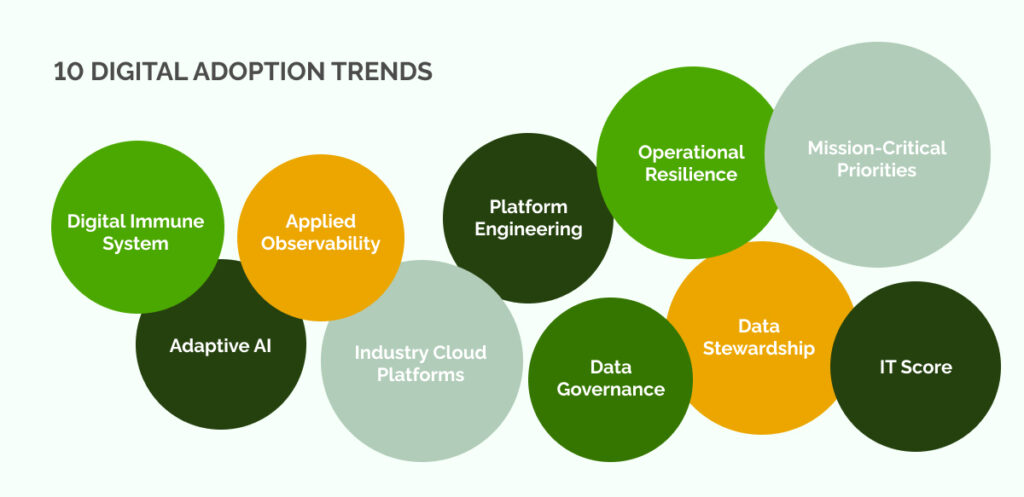
Now that we’ve explained the value of digital adoption in modern times let’s delve into this year’s most prominent trends and provide readers with an invaluable resource to understand and capitalize on digital opportunities.
1. Digital Immune System
A recent Gartner report concerning software application engineering brings forth the concept of Digital Immune Systems, which the research and consulting firm says “creates an enhanced customer experience by combining multiple software engineering strategies to protect against risk. Through observability, automation, and extreme design and testing, it delivers resilient systems that mitigate operational and security risks.”
Businesses must have the proper protection in place to reduce risk. A comprehensive digital immune system should be developed with software design, intricate digital systems, development, operations, and analytics combined. This will ensure businesses are fully equipped with the safeguards they need for optimal security.
2. Applied Observability
Applied observability is formed by using observable data in a well-orchestrated and interconnected way across applications, operations teams, and business functions.
Applied observability can be defined as the ability to observe and analyze the behavior of a system, including its underlying elements and their interactions. The goal is to provide deep insights into how an application works and behaves under different operating conditions and to generate actionable insights that can be applied to improve the performance of a system.
Utilizing such an approach grants the ability to proactively identify emerging issues with increased effectiveness and accuracy and ultimately helps ensure service quality and reliability.
3. Industry Cloud Platforms
Industry Cloud Platforms are cloud-based solutions that enable industrial companies to access data, applications, and services securely, efficiently, and cost-effectively. They combine cloud computing, enterprise integration, and analytics capabilities to provide a comprehensive platform for connecting software applications with other business systems, such as enterprise resource planning (ERP) or customer relationship management (CRM).
Industry cloud platforms are ideal because they allow companies to quickly and easily deploy, scale, and manage applications on the cloud and provide a comprehensive platform for data collection, storage, and analysis that is secure, reliable, and cost-effective.
Cloud and desktop applications can be deployed on industry cloud platforms, allowing for real-time access and collaboration with stakeholders. Companies can also benefit from shared services such as data storage and analytics, and data engineering, as well as from built-in security and compliance.
4. Platform Engineering
Platform engineering is a forward-thinking field that aims to empower software developers by providing them with cloud-based solutions designed to streamline operations.
These self-service capabilities liberate engineers from tedious manual tasks, allowing teams to access higher productivity levels while building today’s digital products. With its ability to simplify and reduce unpredictability in contemporary software delivery, this newly developed field is a valuable tool that can help developers become more efficient and productive.
5. Adaptive AI
Adaptive AI is a type of artificial intelligence capable of autonomous self-improvement. Adaptive AI systems are designed to continually improve performance when exposed to new data or other environmental changes. Adaptive AI enables machines to learn, interpret, and respond to their environment more dynamically than traditionally programmed systems and can automate complex tasks.
“Adaptive AI systems aim to continuously retrain models or apply other mechanisms to adapt and learn within runtime and development environments — making them more adaptive and resilient to change,” says Erick Brethenoux, Distinguished VP Analyst at Gartner.
6. Operational Resilience
Operational resilience is a concept that encourages business continuity planning to prioritize the effects of disruption in delivering products and services to key individuals or entities, including customers, employees, partners, and suppliers. It is a proactive approach to operational risk management that increases the ability of organizations to sustain and manage operational risks over time.
To ensure successful business delivery and value realization, these initiatives collaborate to manage risk assessments, risk monitoring, and implementing controls that affect employees, processes, technology, and external networks.
A successful operational resilience program addresses the current potential and emerging impacts of operational risks and leverages cyber-physical security measures and sophisticated operational procedures to protect security systems.
7. Data Governance
Data governance (DG) regulates and oversees data usage, availability, integrity, and security in enterprise systems. It’s necessary to ensure that all data an organization uses remains trustworthy, consistent throughout its use, and never misused.
With increased regulations surrounding data privacy becoming more commonplace and organizations beginning to rely heavily on their available analytics for business operations optimization, effective DG has become even more essential.
To enact an effective data governance program, it is essential to create a team of executives and staff from IT and business operations departments that work together. This governing body must include a steering committee and data stewards responsible for implementing the standards, policies, and enforcement procedures set by this group to ensure success.
8. Data stewardship
Data stewardship is paramount to any organization, ensuring data security and accessibility. This process covers all stages of the data lifecycle- from creating to archiving – under the protocol established by an organization’s pre-determined principles for preserving quality and reliability. As these values are essential for success, proper implementation should be a business priority.
Data stewardship encompasses:
- Uncovering the data that an organization holds
- Gaining insight into data location
- Ensuring that the data remains accessible, understandable, secure, and reliable
- Ensuring the accountability and reliability of data traceability
- Establishing and enforcing strict guidelines for the proper usage of data is essential to ensure security and privacy
- Harnessing data to cultivate a progressive culture
- Championing reliable data
9. IT Score
IT Score for CIOs is an invaluable assessment tool to measure the efficacy of IT operating models, allowing organizations to heighten digital ambitions. Gartner’s IT score for CIOs is a straightforward way to evaluate the influence of IT operations in businesses and how effectively it is being employed.
Gartner IT Score for CIOs can Help IT and Digital Leaders:
- Assess the functioning of the IT function in its current condition and at superior maturity levels, as well as gain an understanding of how IT operations are performing enterprise-wide
- Determine the ideal maturity level for achieving success in the digital sphere by evaluating and determining your enterprise’s desired goals, then using that as a benchmark for attaining optimal maturity levels
- Accelerate your progress and optimize long-term success with a well-thought-out strategy for elevating maturity levels.
10. Mission-Critical Priorities
Mission-critical priorities are a prime concern for immediate operations and should be addressed with the greatest urgency. Regular preventive maintenance and continuous improvement plans are essential to ensure mission-critical priorities remain in top working order.
Creating, supervising, and reacting to high-priority issues should be essential to any overarching plan. By monitoring mission-critical priorities, you’ll ensure the safety and dependability of your critical applications.
Organizations must create an effective disaster recovery plan to ensure mission-critical operations remain secure, reliable, and of the highest caliber. This strategy should be designed to quickly address unexpected outages to maintain reliability in areas of utmost importance.
Successful Strategies and Best Practices for Transforming Customer Experiences
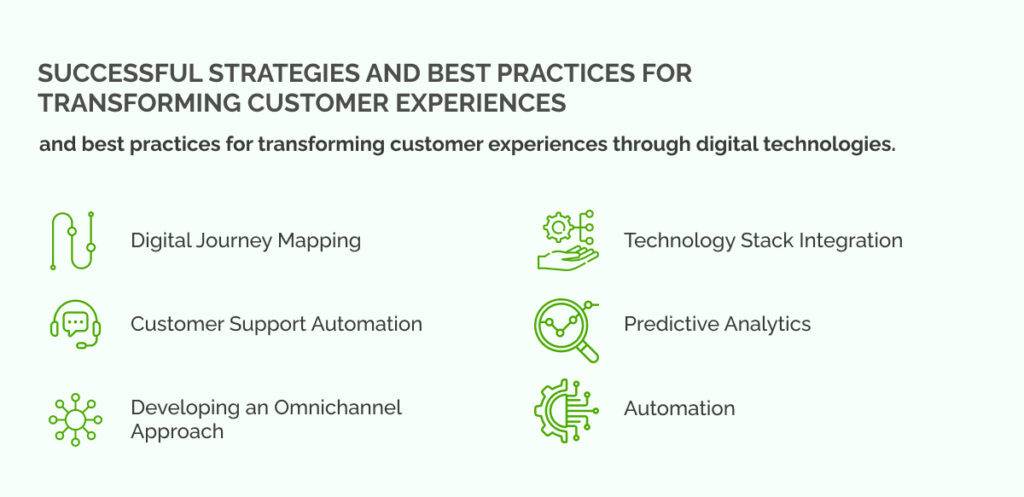
Enhancing customer experiences (CX) is the crux of digital transformation initiatives. An example is how organizations adopt and implement new technologies and must ensure that customers can access those applications and utilize them effectively.
Understanding the needs and expectations of customers is a key prerequisite of agile digital transformation, and organizations will need to rely on relevant data to inform them on how to best align customer experiences with adopting new technology.
While enhancing customer experiences sits at the crux of digital transformation initiatives, businesses must also be aware that DX trends constantly evolve and require ongoing attention.
Keeping this in mind, the following section of the report provides readers with key strategies and best practices for transforming customer experiences through digital technologies.
These include:
- Digital Journey Mapping – Digital journey mapping is an important tool for understanding how customers interact with a digital product and identifying areas of improvement. Digital journey mapping enables organizations to gain insights into customer behavior, improve navigation, and optimize the overall user experience.
- Customer Support Automation – Automating customer support procedures help streamline customer service processes and improve the overall customer experience. Automation technologies such as chatbots and self-service applications can improve customer service response times, reduce customer frustration, and increase satisfaction.
- Developing an Omnichannel Approach – Utilizing multiple platforms, such as online and offline channels, allows companies to provide a seamless journey across all touchpoints and deliver tailored, personalized end-to-end experiences.
- Technology Stack Integration – Integrating different technologies can help organizations create a more seamless customer experience. This is especially important for customer-facing applications, such as websites or mobile applications
- Predictive Analytics – Predictive analytics can be used to better understand customer behavior and intent. This information can inform the development of targeted campaigns, provide personalized recommendations, and optimize overall customer experiences.
- Automation – Automation can reduce the time customers spend interacting with customer service agents and improve the overall quality of customer service.
Delivering Digital Adoption Through Successful Change Initiatives
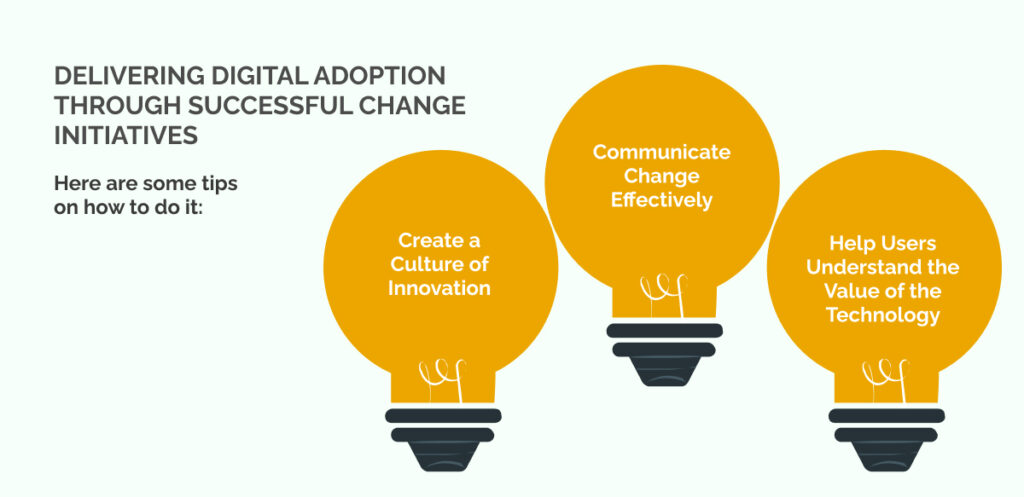
Digital Adoption can only be achieved with successful digital change initiatives in place. Change management is preparing, planning, executing, and managing organizational change to ensure the success of corporate initiatives.
When we look at it from a broad perspective, change management can be divided into two distinct types. One type focuses on managing organizational shifts, while the other deals with technological advancements.
In this regard, digital adoption falls distinctly into the latter definition. It concentrates on empowering users to unlock the full potential of products and applications while at the same time supporting change management objectives.
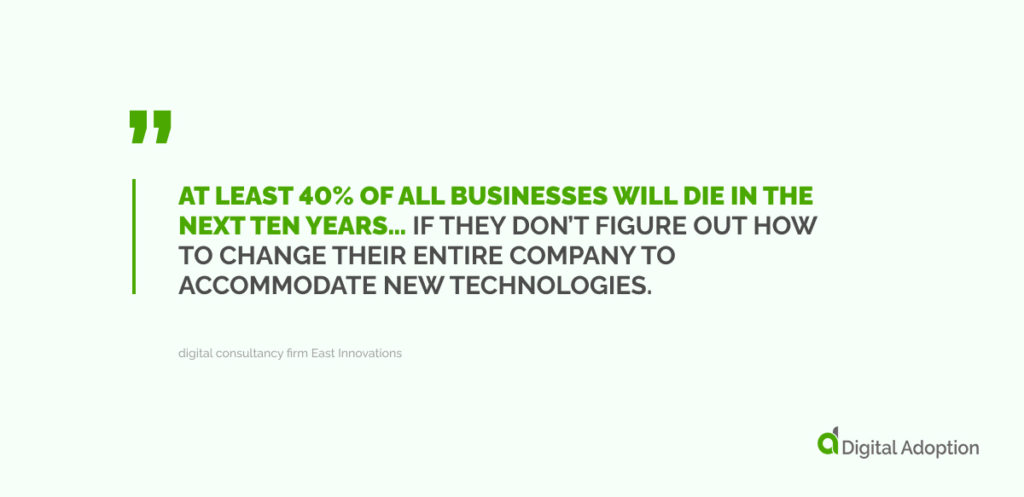
According to the digital consultancy firm East Innovations, “At least 40% of all businesses will die in the next ten years… if they don’t figure out how to change their entire company to accommodate new technologies.”
Many factors can be reasons for static digital adoption, including lack of user familiarity with new technology, resistance to change, and slow adaptation time. As such, change managers and digital leaders must work together to create holistic strategies that address all these elements.
As a digital leader, you can provide invaluable guidance to help new users successfully traverse the digital adoption learning curve.
Here are some tips on how to do it:
- Create a Culture of Innovation
Organizations should focus on creating a culture of innovation that encourages employees to think outside the box and develop creative solutions to problems.
Leaders can foster this environment by providing employees with the necessary resources and support to succeed. This includes offering training, mentorship programs, and incentives for digital tools employees use daily while equipping them with the required digital dexterity skills to accomplish what they can. This should be done by providing consistent and contextual software experiences tailored for end-users.
Most software users reported that their organization does not provide role-specific software onboarding, training, or user support. Software adoption is among the most important factors in successful implementation and can be the difference between success and failure.
Software adoption challenges can include a lack of knowledge or familiarity with the tools, low engagement, and slow adoption. Organizations can overcome these challenges by providing role-specific software onboarding and training, developing user onboarding plans that include clear objectives and performance metrics, establishing user support systems with detailed FAQs, tutorials, and help documentation, and encouraging user feedback to help refine the tools.
- Communicate Change Effectively
Digital adoption initiatives should have a clear communication strategy that outlines how new changes and solutions will be presented to users.
This is because change is often seen as a disruption that can be difficult to accept, and it’s critical digital leaders explain the benefits of new digital solutions in terms of improved user experiences and enhanced productivity. Change managers also need to identify who should be the messengers, when it is best to communicate, and what channels should be used.
Change managers should consider communication methods with stakeholders, such as email notifications, on-site announcements, internal social media channels, and face-to-face meetings. When users are well-informed about changes in advance, they are more likely to accept and embrace them.
- Help Users Understand the Value of the Technology
Digital leaders and change managers must demonstrate how digital tools and technologies can help employees achieve their goals. They should communicate the value of technology and the benefits of becoming proficient in its use by providing real-world examples of how it helps users in their day-to-day activities and duties.
Leaders should also allow users to discover how digital tools can increase productivity, improve efficiency and solve specific problems, such as reducing costs or speeding up communication.
In addition, they should explain how digital tools can be harnessed to generate new ideas for problem-solving and strategizing, create better connections that aid collaboration, and help users produce more accurate results.
For example, project management tools that allow teams to coordinate multiple tasks and track progress can help improve productivity; data analysis tools can provide insights into customer behavior, enabling smarter decisions that maximize sales; and communication apps can streamline internal processes, helping teams work faster and smarter.
Leveraging Digital Adoption To Drive Business Transformation
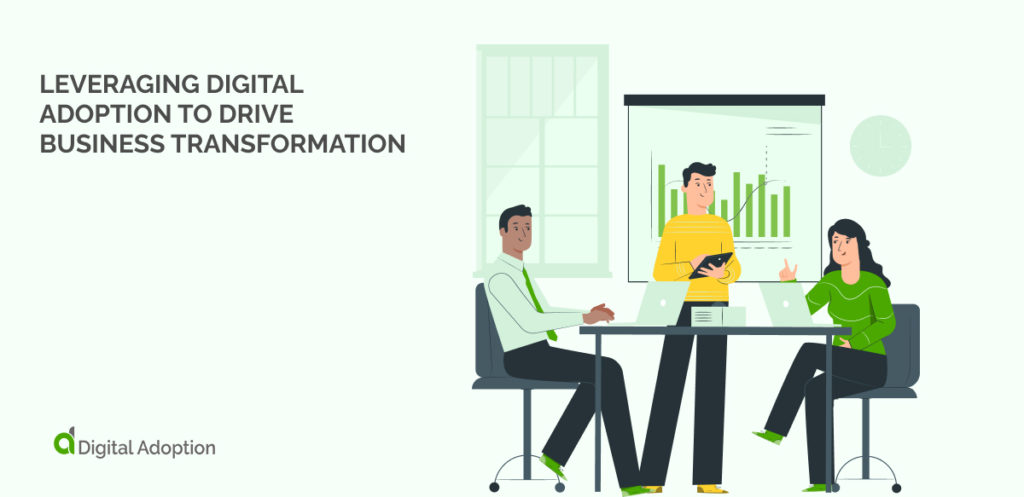
A primary focus for businesses is driving business transformation through successful digital adoption initiatives. This could include optimizing automation and workflow processes across departments, increasing digital channels for customer outreach and engagement, or allowing employees to access critical applications anywhere at any time.
Such solutions can reap several benefits, including increased business speed and agility, improved customer experience, faster development of products and services, streamlined operational processes, and the ability to free up resources for higher-value tasks.
Business transformation is about more than just technology; it’s about the people using it and how they interact. Digital adoption initiatives should be implemented to ensure that employees are equipped with the necessary skills, processes, and tools to make organizational pursuits successful.
Gary Adler, CDO of the multinational law firm Minter Ellison shared his thoughts on the modern applications of DX via Gartner’s recent digital adoption survey, stating:
“As a part of digital transformation, we have changed the way [we] work. …We have given [our employees] new tools like artificial intelligence, robotic process automation, and workflow streamline tools. We are right there at the core of the strategy of the firm, really helping to lead and deliver change and transformation.”
Successful digital adoption initiatives should act as engines of change inside organizations. They should not be seen as a one-off project but as part of an ongoing effort to continually identify and implement new digital technologies that will drive business transformation.
How To Accelerate Digital Adoption & Digital Transformation Initiatives
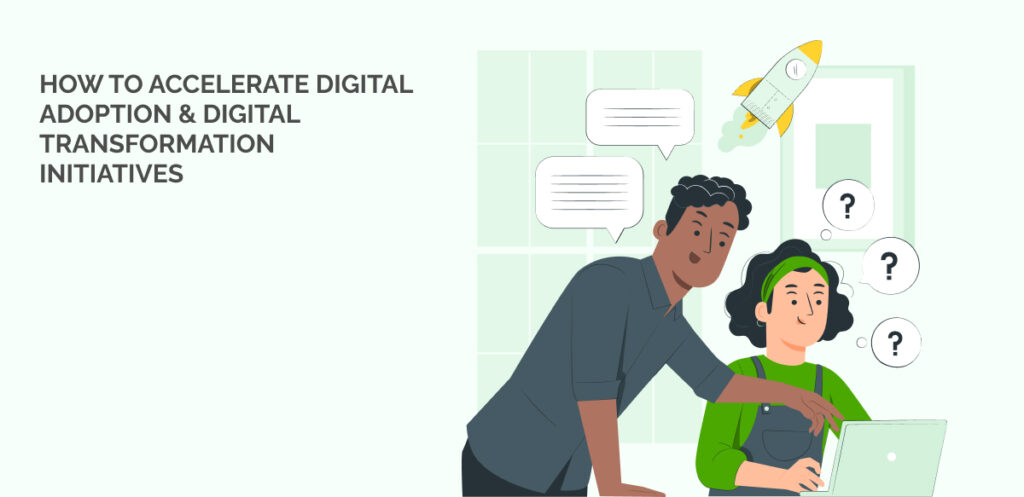
The race is on for organizations to accelerate their digital transformation initiatives in the face of expediting global challenges.
Gartner statistics reveal that digital transformation initiatives are only successfully brought to scale by 40% of businesses, despite 87% of senior business leaders agreeing digitalization is a company priority.
Successfully scaling digital initiatives within technical and organizational environments first requires identifying viable areas of application. Gaining an overview of the organization and the ability to quickly identify these areas is key for affecting change.
Organizations with siloed ecosystems and insular departments often need more cross-sector collaboration, which can breed stagnancy and work to inhibit these changes. Instead, business leaders should opt for a holistic approach that embeds transparency, visibility, coordination, and collaboration across company culture.
Creating an advantageous digital ecosystem requires combining leading minds and employees with a passion for competitiveness, productivity, and teamwork. Facilitating access to external sources and forming partnerships with cutting-edge companies emerges as an additional solution for expediting a company’s digital transformation efforts.
Moreover, emergent technologies can prove disruptive when organizations try to implement them. This is true for core business operations, customer service, digital marketing, and other processes.
Navigating disruptions to business operations means being prepared to quickly adapt and modify existing processes, products, and services on the fly. This can be done by implementing agile methodologies, DevOps processes, microservices, and more.
By figuring out how to scale digital endeavors without disrupting existing processes, organizations can start to put pieces together to accelerate their digital transformation approach.
Whether it be the multi-pronged complexity of business operations combined with the sporadic emergence of disruptive technologies or siloed ecosystems perpetuating inefficiencies in legacy systems, organizations face various challenges when looking to scale transformation efforts.
CIOs, CDOs, and business leaders looking to make the most of their digital transformation projects must be willing to face numerous barriers that necessitate more than technical proficiency- a creative outlook and strategy are also paramount.
Those who can recognize and execute the numerous plans and technologies available will be seen as leaders in this space.
Take your business to the next level by following these best practices for accelerating digital adoption initiatives.
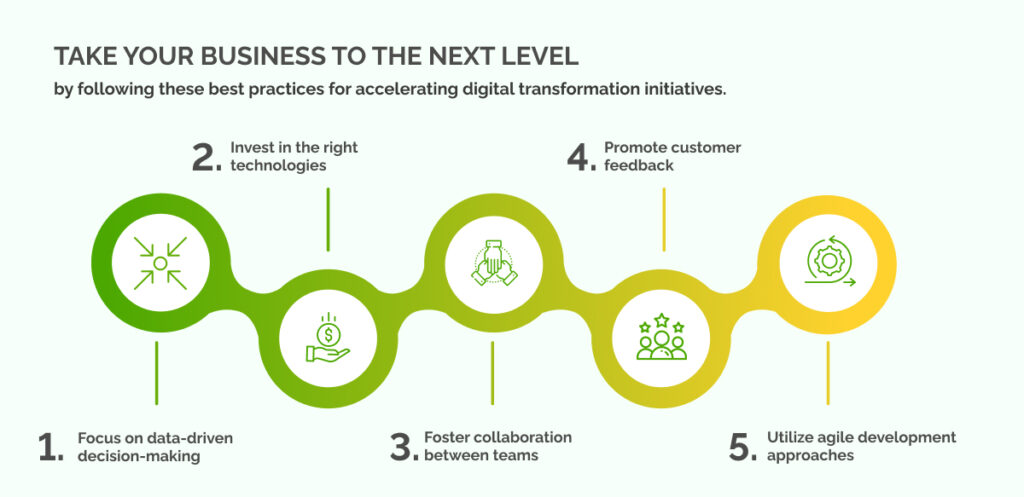
- Invest in emerging technologies, such as AI and machine learning, to stay ahead of the competition.
- Harness the power of user-generated content to create an engaged online community around the brand.
- Utilize data analytics to gain insights into customer behavior and tailor digital experiences accordingly.
- Integrate a range of devices into one unified platform for a seamless end-user experience.
- Ensure security is a top priority when handling customer data to protect the company and customers’ information.
Take your business to the next level by following these best practices for accelerating digital transformation initiatives.
1. Focus on data-driven decision-making: Gathering and analyzing customer data is essential for understanding customer needs and preferences. Companies must leverage the power of data to make informed decisions about their digital transformation initiatives.
2. Invest in the right technologies: Choosing the right technologies to meet current and future business objectives is critical for successful digital transformations. Organizations should consider solutions such as AI, Cloud Computing, IoT, RPA, etc., to increase operational efficiency and gain a competitive edge.
3. Foster collaboration between teams: Digital transformation initiatives require multi-disciplinary teams with diverse skill sets to collaborate effectively throughout the process. Encouraging collaboration between cross-functional teams will help ensure successful outcomes while creating a culture of teamwork and innovation.
4. Promote customer feedback: By asking customers for their opinion and suggestions, organizations can better understand their needs and create better solutions to meet them. Companies should actively seek customer feedback to increase customer satisfaction and loyalty as part of their digital transformation strategies.
5. Utilize agile development approaches: Agile methodologies are key for fast, flexible, and customer-centric digital transformations. Companies should focus on developing easily adaptable products to changing customer needs over time.
What’s Next For Digital Adoption?
The digital transformation of businesses – including up-and-coming startups and established enterprises – has become an integral part of any successful organization’s business model.
According to IDC, the worldwide expenditure on digital transformation (DX) of business operations, products, and organizations is projected to reach $2.8 trillion by 2025. In addition, DX spending will register a CAGR of 16.4% between 2021-2025, representing tremendous growth potential for those invested in this area.
However, the swift rise of technology trends, such as digital transformation initiatives, has caused a wide disparity between technology capacities and business outcomes. In simpler terms, the potentials of digital transformation are not being realized due to inadequate user adoption—this is known as the ‘digital adoption gap.’ Overcoming this void in usage can ultimately unlock all of the value software investments currently cannot provide because they lack successful utilization rates.
Top analysts believe the future of digital adoption depends upon the successful combination of emerging technologies, the demand for more agile, advanced strategies, and the commitment of C-level executives to invest in the DX journey. The most effective digital adoption strategy will involve a well-designed roadmap, strong executive sponsorship, and alignment of the right people, processes, and technology.
You can support adoption strategies by understanding user needs, providing comprehensive training, incentivizing usage, offering support, and encouraging feedback. Business process improvements and automation, combined with a well-planned governance program, can help ensure the successful adoption of digital solutions and technologies.
In Forrester’s North American Predictions for 2022, the market research firm states that “[…] business leaders will invest in technology and refocus business strategies. AI adoption and tech spending will accelerate. Tech companies will jump into adjacent markets, equally capitalizing on opportunity and sowing confusion.”
As they look to leverage the benefits of digital transformation, we expect digital adoption to become the future state for organizations worldwide. Integrating these technologies, strategies, and business processes into operations will equip organizations with new ideas, techniques, and insights to enhance customer engagement and experience.
The future of digital adoption is undoubtedly bright, and the organizations prepared to accelerate their digital transformation plans now will be well-positioned to benefit from the tremendous opportunities it provides.




![18 Examples of AI in Finance [2025]](https://www.digital-adoption.com/wp-content/uploads/2025/06/18-Examples-of-AI-in-Finance-2025-300x146.jpg)
![14 Examples of AI in Manufacturing [2025]](https://www.digital-adoption.com/wp-content/uploads/2025/06/14-Examples-of-AI-in-Manufacturing-2025-300x146.jpg)
![29 Examples of AI in Education [2025]](https://www.digital-adoption.com/wp-content/uploads/2025/06/29-Examples-of-AI-in-Education-2025-300x146.jpg)
![15 Examples of AI in Retail [2025]](https://www.digital-adoption.com/wp-content/uploads/2025/06/15-Examples-of-AI-in-Retail-2025-300x146.jpg)
![13 Examples of AI in Healthcare [2025]](https://www.digital-adoption.com/wp-content/uploads/2025/06/AI-in-healthcare-examples-300x146.jpg)

![18 Examples of AI in Finance [2025]](https://www.digital-adoption.com/wp-content/uploads/2025/06/18-Examples-of-AI-in-Finance-2025.jpg)
![14 Examples of AI in Manufacturing [2025]](https://www.digital-adoption.com/wp-content/uploads/2025/06/14-Examples-of-AI-in-Manufacturing-2025.jpg)
![29 Examples of AI in Education [2025]](https://www.digital-adoption.com/wp-content/uploads/2025/06/29-Examples-of-AI-in-Education-2025.jpg)